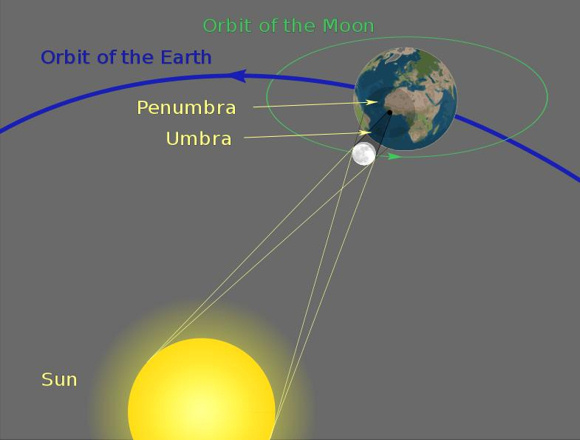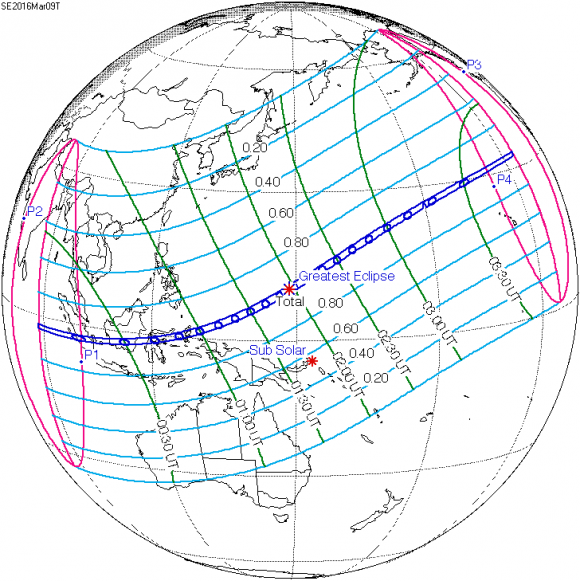The moon turns new on March 8 or 9, 2016, depending on your time zone. The new moon happens one day before the moon reaches lunar perigee – the moon’s closest point to Earth in its orbit. Thus this new moon counts as a supermoon. It won’t be visible in our sky, but it’ll line up with the sun to create a larger-than-average effect on Earth’s oceans. Plus this new supermoon swings right in front of the sun, so if you’re at the right place on Earth, you might be able to view the new moon silhouette in front of the sun (but remember to use proper eye protection). The eclipse will begin at 23:19 UTC on March 8, 2016, and its maximum point will take place at 01:59 UTC on March 9, 2016. Totality will last for 4 minutes and 9 seconds. Follow the links below to learn more.
Who will see the March 8-9 eclipse?
How to watch an eclipse safely
March 9 total eclipse times from land
March 8-9 partial eclipse times
Still not sure when to watch? Try these links
How often does a solar eclipse happen on the March equinox?
EarthSky’s once-a-year fundraiser going on now. Please donate to help us keep going!
Who will see the March 8-9 eclipse? Note on the worldwide map above that the path of totality (in dark blue) passes mainly over the waters of the Pacific Ocean. Only those along that long yet narrow path can see the total eclipse of the sun. The path of totality starts at sunrise in the Indian Ocean to the west of Indonesia, and then goes eastward across the Indian and Pacific Oceans until it ends to the west of North America at sunset.
On a worldwide scale, the whole total eclipse from start to finish lasts for over three and one-third hours, yet at any point on the Earth’s surface, the maximum duration for the total eclipse is just over four minutes. The black dot on the animation to the right shows the path of totality whereas the larger gray circle depicts where a partial solar eclipse is visible.
The best spots to watch this total solar eclipse from land are the various islands in Indonesia, which reside on the path of totality. See Eclipse times for total eclipse below.
A much larger swath of the world gets to see varying degrees of a partial solar eclipse. Hawaii and Alaska see the partial eclipse at late afternoon on March 8, while south and eastern Asia, Korea, Japan, north and western Australia see it on the morning of March 9. Eclipse times for partial eclipse below.

How to watch an eclipse safely. Remember to use proper eye protection if you want to observe this eclipse!
The photo above shows one method for safely watching the partial phases of a solar eclipse: the projection method.
You can also view an eclipse safely through special eclipse glasses. Purchase eclipse glasses from the EarthSky store.
Click here for more details on how to watch a solar eclipse safely.

March 9, 2016 total eclipse times from land
Palembang, South Sumatra, Indonesia
Partial solar eclipse begins: 6:20 a.m. local Western Indonesian Time
Total solar eclipse begins: 7:20 a.m. local time
Maximum eclipse: 7:21 a.m. local time
Total solar eclipse ends: 7:22 a.m. local time
Partial solar eclipse ends: 8:31 a.m. local time
Balikpapan, East Kalimantan, Indonesia
Partial solar eclipse begins: 7:25 a.m. local Central Indonesian Time
Total solar eclipse begins: 8:33 a.m. local time
Maximum eclipse: 8:34 local time
Total solar eclipse ends: 8:34 a.m. local time
Partial solar eclipse ends: 9:53 a.m. local time
Sofifi, North Maluhu, Indonesia
Partial solar eclipse begins: 8:36 a.m. local Eastern Indonesian Time
Total solar eclipse begins: 9:51 a.m. local time
Maximum eclipse: 9:53 local time
Total solar eclipse ends: 9:54 a.m. local time
Partial solar eclipse ends: 11:21 a.m. local time
Source: TimeandDate.com

March 8, 2016 partial eclipse times
Honolulu, Hawaii
Solar eclipse begins: 4:33 p.m. local Hawaii-Aleutian Standard Time
Greatest eclipse: 5:36 p.m. local time
Solar eclipse ends: 6:33 p.m. local time
Maximum obscuration of solar disk: 63.4%
Anchorage, Alaska
Solar eclipse begins: 5:38 p.m. local Alaska Standard Time
Greatest eclipse: 6:12 p.m. local time
Solar eclipse ends: 6:45 p.m. local time
Maximum obscuration of solar disk: 9.5%
March 9, 2016 partial eclipse times
Hong Kong, China
Solar eclipse begins: 8:05 a.m. local Hong Kong Time
Greatest eclipse: 8:58 a.m. local time
Solar eclipse ends: 9:56 a.m. local time
Maximum obscuration of solar disk: 22%
Darwin, Australia
Solar eclipse begins: 9:07 a.m. local Japan Standard Time
Greatest eclipse: 10:17 a.m. local time
Solar eclipse ends: 11:34 a.m. local time
Maximum obscuration of solar disk: 50.3%
Tokyo, Japan
Solar eclipse begins: 10:12 a.m. local Japan Standard Time
Greatest eclipse: 11:08 a.m. local time
Solar eclipse ends: 12:05 p.m. local time
Maximum obscuration of solar disk: 15.4%
Still not sure when to watch? Try these links
You can obtain specific information on the March 8-9 eclipse in your part of the world at the sites listed below. Be sure to watch whether the times are given in Universal Time, meaning you must convert Universal Time into your local time.
TimeandDate.com – gives eclipse times in local time
HM Nautical Almanac – eclipse animations for 246 localities
Interactive Google map – information is just a click away
Solar eclipse computer – courtesy of the US Naval observatory
Hermit Eclipse – select your preferred time zone

A solar eclipse happens whenever the new moon passes in front of the sun, and the moon’s shadow falls on our planet. A solar eclipse is only possible at new moon because that’s the only time whereby the moon can go in front of the sun, as seen from Earth. Most of the time, however, the new moon either swings north or south of the solar disk, so no eclipse of the sun takes place.
The plane of the moon’s orbit around Earth is inclined at 5o to the plane of the Earth’s orbit around the sun. For half the month, the moon orbits Earth to the north of the ecliptic (Earth’s orbital plane); and for the other half of the month, the moon orbits Earth to the south of the ecliptic (Earth’s orbital plane). Twice a month, the moon crosses the Earth’s orbital plane at points called nodes. If the moon is traveling from north to south, it’s called a descending node, and when it’s going from south to north, it’s called an ascending node.
When a new moon happens while the moon is appreciably close to one of its nodes, a solar eclipse is not only possible – but inevitable. This time around, the moon reaches its descending node only about 5 hours after the moon turns new. The close coincidence of new moon with its descending node means the moon’s dark umbral shadow will cross the Earth’s surface for about 3 and one-third hours, the long umbra track covering about 14,200 kilometers (8,820 miles) on the Earth’s surface, though with a width of only 156 kilometers (97 miles) at its widest point.
Path of total solar eclipse of 2016 March 9
Bottom line: On March 8-9, 2016 the larger-than-average new supermoon swings right in front of the sun to totally block out the solar disk. Although you have to be at the just right spot on Earth to witness this total eclipse of the sun (Indonesia), a much larger swath of the world gets to see varying degrees of a partial solar eclipse (south and east Asia, Japan, Korea, Australia, Hawaii and Alaska). Remember to use proper eye protection!














